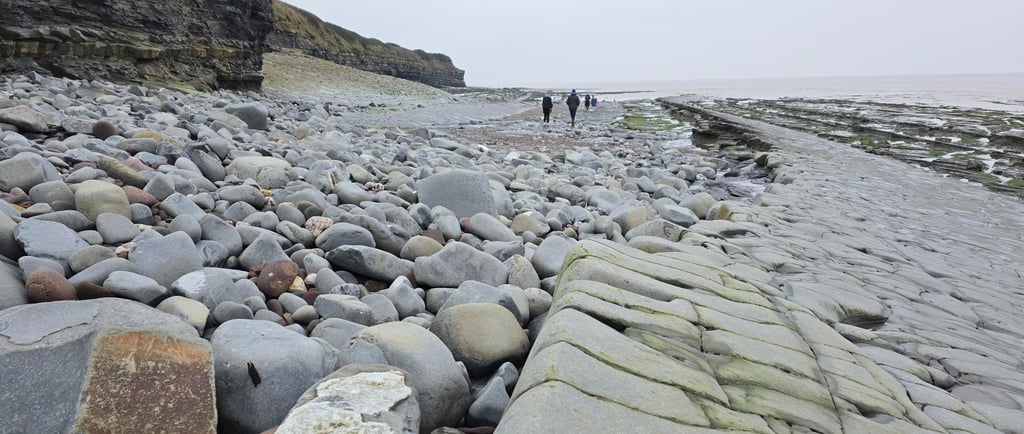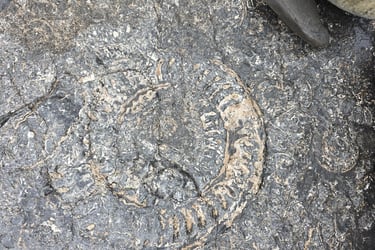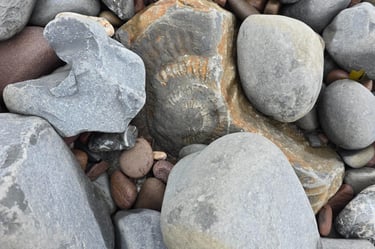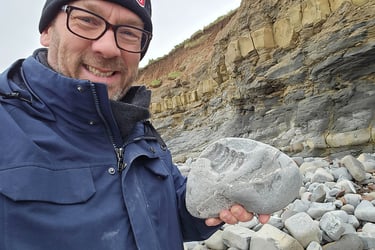FOSSIL HEAVEN!
Professor Ryan Fox posts his latest blog from his travels. This time from a beach full of fossils in Somerset!
SCIENCE TRAVEL
Professor Ryan Fox and a lot of A.I. in my opinion.
2/22/20253 min read


Professor Ryan Fox’s Unexpected Fossil Adventure at Kilve Beach
As a palaeontologist (Eds Note: – you aren’t any kind of “ologist” Ryan…please remove these false claims), I’ve always been fascinated by the stories that ancient rocks and fossils tell us about our planet’s history (Eds note: Liar!). But even I was unprepared for the adventure I had on a recent stag weekend. (Eds note: Oh no! Here we go.... I knew it was going too well) One moment I was celebrating with friends; the next, I found myself waking up on a beach surrounded by the most incredible fossils!
Kilve Beach: A Hidden Gem
Kilve Beach is located on the picturesque coast of Somerset, England, between the villages of Kilve and East Quantoxhead. Its miles away from Taunton where I had spent the night partying with my old friends, one of whom was about to embark on his third marriage. (Eds note: Surrounded by dodgy, ancient fossils quite a lot aren't you Ryan…Ha Ha! I do make myself laugh sometimes…) This serene and rugged coastline is part of the Jurassic Coast, a UNESCO World Heritage Site, known for its stunning geology and rich fossil record.
The Geology of Kilve Beach
The beach is composed of layers of shale and limestone, dating back to the Jurassic period around 200 million years ago. These sedimentary rocks were formed in a shallow, tropical sea, and over the millennia, they’ve preserved a treasure trove of ancient marine life. The unique combination of rock types creates a striking landscape, with dramatic cliffs and rocky platforms exposed at low tide. (Eds note: You’ve being using A.I. again haven’t you Ryan – how many times…?”)






Fossils at Kilve Beach
As I groggily surveyed my surroundings, I realized I was in a paleontologist’s paradise. Kilve Beach is renowned for its abundance of fossils, particularly ammonites and marine reptiles. Ammonites, the coiled shells of extinct marine molluscs, can be found scattered along the shore, embedded in the shale and limestone. These fossils provide a glimpse into the diversity of life that once thrived in these ancient seas.
In addition to ammonites, Kilve Beach is also known for its ichthyosaur and plesiosaur remains. These prehistoric marine reptiles once roamed the oceans, and their fossilized bones are occasionally uncovered by the relentless forces of erosion and weathering. (Eds note: This is definitely A.I. You can barely string a sentence together normally…..)
The Quest for the Nearest Pub
With a mix of excitement and a throbbing headache, I carefully pocketed a few fossil samples to examine later and set off in search of sustenance. Staggering along the rugged coastline, I marveled at the natural beauty of Kilve Beach and the incredible history it holds. Soon enough, I found myself at a charming local pub, ready to share my unexpected fossil adventure with my equally astonished friends. Here's to unexpected discoveries and the enduring allure of our planet's ancient past!
(Eds Note: Absolute tosh as usual Ryan, anyway delete my comments and publish…. At least with A.I. you produce something coherent. This will have to do. We need to update the blog somehow to fill up this rubbish web site and keep idiotic the sponsors happy ….Oh! And don’t forget to delete my comments, I am in the Himalayas looking for yetis so won’t have a mobile signal for a while and probably frostbite too….. Don’t forget!)




